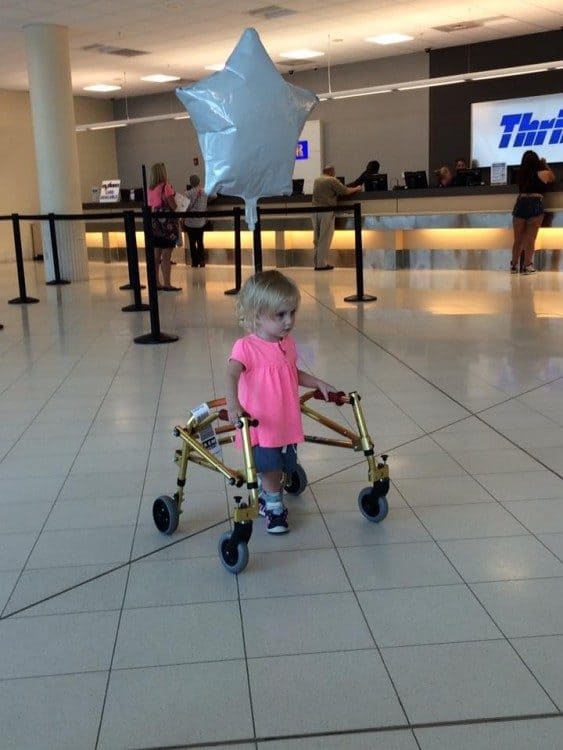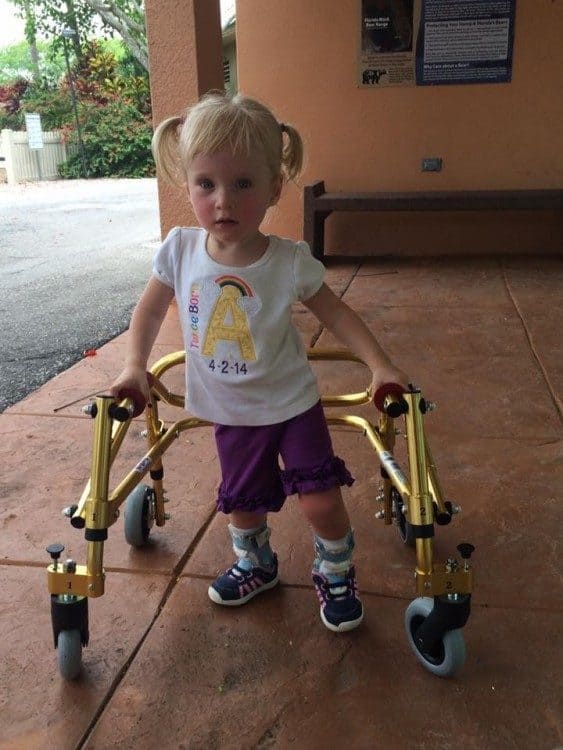We were at the airport, coming back from a wonderful, week-long beach vacation with extended family. Having arrived early with our two young children in tow, we took it upon ourselves to try to keep them occupied and in a good mood for the flight back home. The airport was pretty empty, so it was the perfect opportunity for our almost 2-year-old, Adelaide, to practice walking with her walker. Adelaide has spina bifida and just started using a walker a month prior. Getting her to the point of walking with a walker has been no small feat, let me tell you.

For once, she happily agreed to go exploring with her walker, and I proudly walked next to her, pointing out the little airport shops and knick-knacks they sold. She stopped every so often to dance to the music playing over the speakers. People waved to her, and she smiled back at them. People complimented her, telling her what a good job she was doing, and I thanked them in return, swelling with pride.
When we made it back to our gate, she ditched her walker and crawled over to her brother to play with him. I sat down with my coffee. The man next to me, a stranger, leaned toward me and asked, “Why does she wear those things on her legs?”
“Her braces?” I replied, “Those are to help provide support and stability for when she walks.”
“Oh,” he replied, and went on to tell me that his daughter had something similar when she was young, but she didn’t need them anymore. “What does she have?” he asked, obviously referring to her disability.
I replied that she has spina bifida.
“Will she grow out of it?” he asked.
“No. Spina bifida is permanent. You are either born with it or you aren’t. But that’s OK. She’s doing great,” I responded awkwardly, as I have never really had conversations with strangers about Adelaide’s disability.
“That’s a shame that she has to use that,” he responded, pointing to her walker. “I just hate to see someone so young struggle so much already in life.”
Struggle? Adelaide’s amazing ability to walk was a struggle? I was puzzled; that was not how we viewed it. Not even close. I didn’t really know how to respond to him. I guess it’s the first time I saw her from a stranger’s point of view. To us, her ability to walk is an achievement, not something to pity. We are very proud of her for that accomplishment, as we knew there could have been chance that she would have never been able to walk at all with her diagnosis. We are grateful she can use a walker, so unbelievably grateful.

The first time Adelaide’s therapist sent me a video of her using a walker while I was at work, I wept. Like shoulders heaving, face swelling, nose running kind of weeping. I guess you could say I “ugly cried.” It was the most beautiful thing I’d ever seen in my life. She’s gotten so much better in that one month of walking, too. When I see her use her walker, I see a child that is looking at her peers at eye level instead of looking up at them from crawling around on the ground. When she uses her walker, she doesn’t have to wear knee pads that need constant adjusting. When she uses her walker, I don’t have to wipe blood and dirt off her knees and hands. When she uses her walker, sometimes she announces her pride in herself as well: “I’m walking! I’m walking!” she will yell to us excitedly.
I wish I had the words at that moment to tell that man those things, but I was too caught off guard to express those thoughts. I wish I could have conveyed even the slightest amount of our pride in her accomplishment, because it’s been something we’ve worked diligently toward ever since she was born screaming and kicking her legs.
I suppose I will be better prepared next time. At least I hope I will be.
This guest post was written by Kristy Sullivan.

